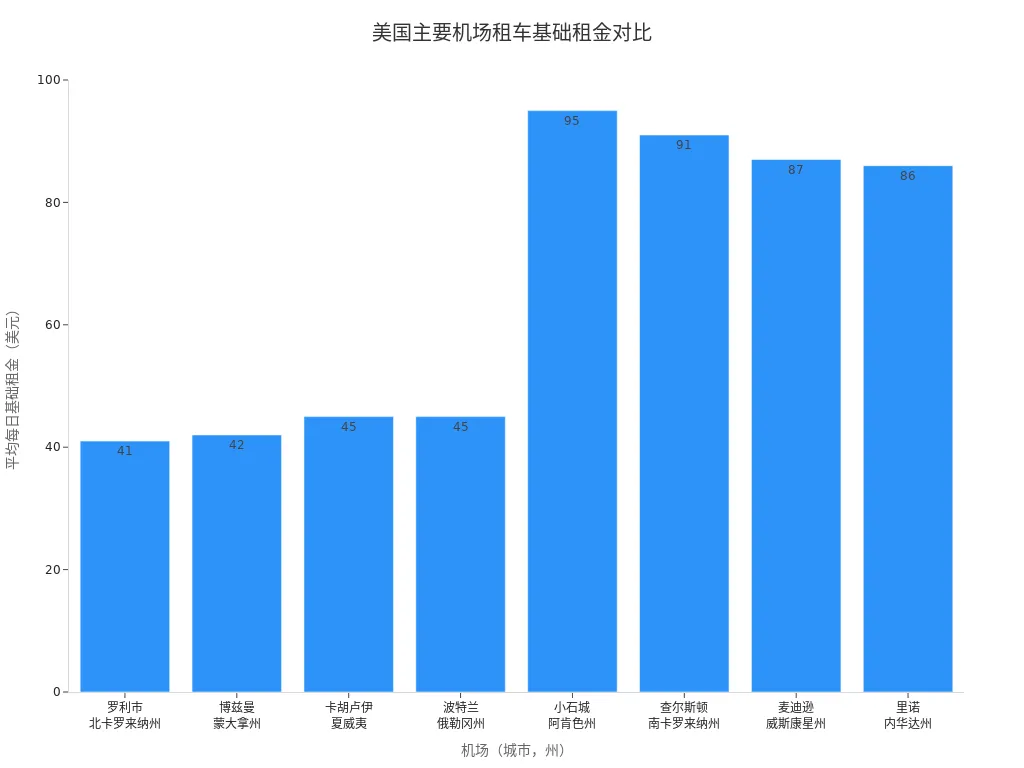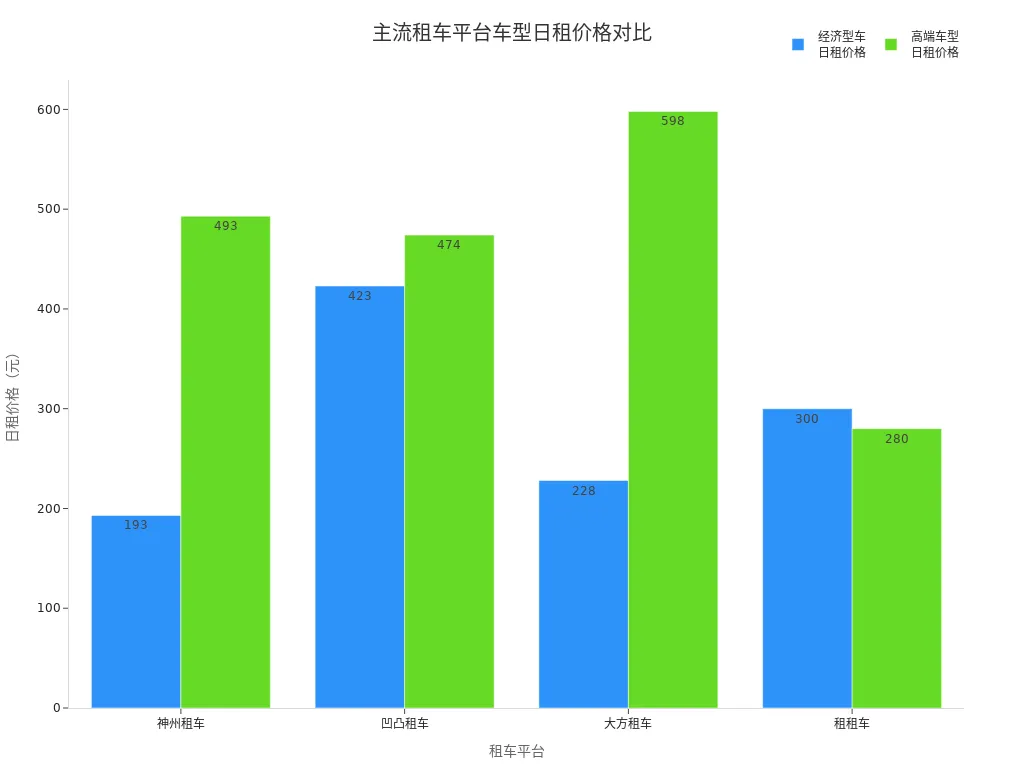- EasyCard
- Trade
- Help
- Announcement
- Academy
- SWIFT Code
- Iban Number
- Referral
- Customer Service
- Blog
- Creator
U.S. Car Rental Guide: Rental Platforms, Apps, Prices, and Required Documents

Image Source: pexels
In the U.S. car rental guide, you need to prepare your original Chinese driver’s license and an English translation in advance, and your passport is also essential. Rental companies typically require the primary driver to have a credit card, with deposit requirements for some models reaching up to $1,000. Regarding age, you generally need to be 25 or older, though some states allow rentals from age 18 with additional fees. You also need to provide a booking confirmation to ensure all documents are complete for a smooth booking, pickup, and return process.
Key Points
- To rent a car in the U.S., you must prepare your original Chinese driver’s license, an English translation, passport, and credit card with a minimum credit limit of $1,000.
- When choosing a rental platform, compare prices and services from traditional rental companies, comparison platforms, or P2P platforms; booking in advance can save costs.
- Rental costs include base rates, insurance, and various additional fees; understanding price differences across airports and seasons helps with budgeting.
- During booking and pickup, carefully verify documents, contracts, and deposit policies; inspect the vehicle thoroughly during pickup and return to avoid disputes.
- Follow U.S. traffic rules, including speed limits, parking signs, and seatbelt use, to avoid fines and ensure a safe and smooth road trip.
Required Documents for Car Rental

Image Source: pexels
Driver’s License and Translation
When renting a car in the U.S., you must have your original Chinese driver’s license. If your license is not in English, you also need to prepare an English translation or an International Driving Permit (IDP). An IDP cannot be used alone as a valid driving document; you must carry your Chinese driver’s license alongside it. Recognition of foreign licenses varies by state, so you should check the specific regulations of your destination state in advance. An IDP mainly serves as a supplementary document to facilitate communication during rental or police checks.
Tip: Some rental companies may require a specific translation template or a document issued by a designated translation agency. You can prepare an English translation at a Chinese notary office in advance to ensure compliance.
Passport and Credit Card
Your passport is a mandatory document when renting a car in the U.S. Rental companies use it to verify your identity. You also need a credit card with a typical minimum credit limit of $1,000. Rental companies will place a hold on a deposit when you pick up the car, with deposits for standard models around $500 and up to $1,000 for premium models.
Note: Rental companies generally do not accept debit cards or cash for deposits. You can use an international credit card issued by a Hong Kong bank, ensuring sufficient credit to avoid rejection during pickup.
Age and Deposit
U.S. rental companies have clear age requirements for drivers. You must be at least 20 years old to be an authorized driver. Most companies require drivers to be 25 or older to avoid young driver surcharges. If you are under 25, rental companies will charge an additional young driver fee, which varies by company and vehicle type, typically requiring an extra daily fee.
- In Michigan and New York, drivers aged 18 to 24 can rent a car by completing an authorized driver registration form but will still incur young driver surcharges.
- If your spouse or cohabitant is 25 or older and holds a recognized driver’s license, they can drive the rental vehicle without additional registration or fees.
- Only authorized drivers may operate the rental vehicle; driving by others is considered a violation.
Deposit amounts vary based on the vehicle type and rental company policy. Standard models typically require a $500 deposit, while premium models may require $1,000. All deposits must be paid via credit card, with the amount held during pickup and released upon return if there are no violations or damages.
Reminder: When selecting a vehicle and rental duration, familiarize yourself with deposit policies in advance and ensure sufficient credit card limits to avoid itinerary disruptions.
U.S. Car Rental Platform Selection
Traditional Rental Companies
In the U.S. car rental guide, you’ll frequently encounter traditional rental companies like Hertz, Avis, Alamo, and Enterprise. These companies have numerous locations and standardized services. You can easily find their outlets at airports and downtown areas. Traditional companies support bookings via their websites, apps, or in-person. You can complete the rental process with a Chinese driver’s license and English translation. Most companies offer Chinese-language interfaces for ease of use. Choosing traditional companies often provides higher vehicle reliability and comprehensive customer service.
Tip: Booking in advance on their websites or apps often yields lower prices than on-site rentals.
Comparison and Agency Platforms
To save on costs, you can use international comparison platforms like Expedia, AutoEurope, or Booking.com. These platforms compare prices and vehicle types across multiple rental companies. You can also use Chinese platforms like Zuzuche or Ctrip, which offer Chinese-language interfaces tailored for Chinese users. Prices on these platforms typically include insurance and taxes, simplifying the process. When using comparison platforms, you can quickly find the best rental deal for your needs.
Note: Prices on Chinese agency platforms are often all-inclusive, unlike the base rates shown on U.S. company websites.
P2P Rental Platforms
For a more flexible rental experience, you can opt for P2P platforms like Turo or Getaround. These allow you to rent directly from car owners, offering a wide range of vehicle options, sometimes at lower prices than traditional companies. You operate through their apps, and the process is straightforward. You need to upload your driver’s license and credit card information, and some platforms accept Chinese licenses. P2P platforms are ideal for short-term or temporary rentals. Note that insurance terms and service standards on P2P platforms differ from traditional companies, so read their policies carefully.
Prices and Fees
In the U.S. car rental guide, you need to understand the components of rental costs. These primarily include base rates, insurance, taxes, and various additional fees. Prices vary by platform, vehicle type, and pickup/return location. Familiarizing yourself with these costs helps you budget effectively.
Base Rates
Base rates are the primary expense when renting a car in the U.S. Prices vary significantly by city, airport, and season. At Raleigh, North Carolina’s airport (RDU), the average daily base rate is $41. At Bozeman, Montana’s airport (BZN), it’s about $42 per day. Kahului, Hawaii (OGG), and Portland, Oregon (PDX) average $45 per day. Some airports, like Little Rock, Arkansas (LIT), have base rates as high as $95 per day. Fall rental prices are about 28% cheaper than summer. Refer to the table below for base rate levels at different airports:
| Airport Category | Airport Name (City, State) | Average Daily Base Rate (USD) |
|---|---|---|
| Cheapest Airports | Raleigh, North Carolina (RDU) | 41 |
| Bozeman, Montana (BZN) | 42 | |
| Kahului, Hawaii (OGG) | 45 | |
| Portland, Oregon (PDX) | 45 | |
| Most Expensive Airports | Little Rock, Arkansas (LIT) | 95 |
| Charleston, South Carolina (CHS) | 91 | |
| Madison, Wisconsin (MAD) | 87 | |
| Reno, Nevada (RNO) | 86 |

When choosing a pickup location, prioritize airports or downtown locations with lower base rates. Booking in advance and avoiding peak seasons can save significant costs.
Insurance Types
In the U.S. car rental guide, insurance costs are a critical consideration. Rental companies typically offer various insurance options, including Collision Damage Waiver (CDW), Liability Insurance (LI), and Personal Accident Insurance (PAI). You can choose the appropriate combination based on your needs.
- CDW (Collision Damage Waiver): Covers vehicle damage or loss. Purchasing CDW means you won’t have to pay out-of-pocket for accident-related damages.
- Liability Insurance: Covers damages caused to third parties in an accident. Some states legally require liability insurance.
- Personal Accident Insurance: Provides personal injury coverage for you and your passengers.
When booking through Chinese agency platforms, insurance is usually included in the total price. On U.S. company websites, insurance is typically optional, and base prices exclude it. Carefully review insurance terms to avoid duplicate purchases.
Tip: Some credit cards issued by Hong Kong banks include rental car insurance. Check with your card issuer in advance to leverage these benefits and save on insurance costs.
Additional Fees
In addition to base rates and insurance, you need to account for various additional fees, including:
- Taxes: Vary by state, typically ranging from 8% to 15%.
- Drop-off Fees: If you pick up in one location and return in another, you’ll incur a drop-off fee, ranging from $50 to $200.
- Young Driver Fees: If you’re under 25, you’ll pay a daily surcharge of $15–$36.
- Additional Driver Fees: Adding a secondary driver costs $10–$15 per day.
- Equipment Rental Fees (e.g., GPS, child seats): Approximately $5–$15 per day.
Always review the fee breakdown during booking to avoid unexpected costs at pickup.
Price Comparison
In the U.S. car rental guide, you’ll often compare prices across platforms and vehicle types. When booking through Chinese rental platforms, prices are typically all-inclusive, covering insurance and taxes. On U.S. websites, displayed prices are often base rates, with insurance and taxes added separately. Refer to the table below for daily rental prices across platforms and vehicle types:
| Rental Platform | Economy Car Daily Rate (USD) | Premium Car Daily Rate (USD) |
|---|---|---|
| Shenzhou Car Rental | 27 | 69 |
| Aotu Car Rental | 59 | 66 |
| Dafang Car Rental | 32 | 84 |
| Zuzuche | 42 | 39 |

When choosing a platform, compare multiple options. Booking in advance, selecting flexible pickup/return locations, and timing can significantly reduce costs. Look out for platform promotions and credit card discounts to further save on expenses.
Booking and Pickup/Return Process

Image Source: pexels
Booking Steps
You can book online through rental company websites or apps. The process is straightforward and typically includes the following steps:
- Choose a vehicle and rental company. Select based on economy, mid-size, or SUV types, considering luggage space and price.
- Review rental terms. Pay attention to deposit, mileage limits, age requirements, and fuel policies. U.S. rental companies generally use a “full-to-full” fuel policy.
- Enter personal information. Provide your name, phone number, driver’s license number, passport, and primary driver’s credit card details. The credit card must belong to the primary driver.
- Confirm additional drivers. If adding a secondary driver, register them in advance and provide their documents, or insurance won’t apply.
- After booking, you’ll receive a rental confirmation email. Keep it safe, as you’ll need to present it during pickup.
Tip: You must be at least 21 years old, and those under 25 may incur a young driver surcharge. Prepare your Chinese driver’s license, English translation, and a Hong Kong bank credit card in advance.
Pickup Process
Upon arriving at the rental location, follow these steps:
- Present your passport, Chinese driver’s license, IDP (if applicable), and primary driver’s credit card. The rental company will verify all documents and booking details.
- If there are additional drivers, they must present their documents.
- The counter may offer vehicle upgrades or additional insurance. Choose based on your needs to avoid duplicate purchases.
- Select a fuel option: prepay fuel, have the rental company refuel, or refuel yourself. Self-refueling is typically the most cost-effective.
- Review the contract details, including vehicle type, insurance, deposit, return time, and location. Sign after confirming accuracy.
- The rental company will place a hold on the primary driver’s credit card for the deposit, typically $500–$1,000. Prepare multiple Hong Kong bank credit cards in case one is declined.
Return Process
When returning the vehicle, follow these steps:
- Return the vehicle at the agreed time and location. If returning to a different location, notify in advance and pay the drop-off fee.
- Staff will inspect the vehicle’s condition, including exterior, fuel level, and mileage. You’ll settle any violation or damage fees on-site.
- The rental company will release the deposit hold. If there are no issues, the deposit will be refunded to your credit card within days.
- If you receive a ticket or have outstanding fees, the rental company will charge your credit card.
Vehicle Inspection
Inspect the vehicle thoroughly during pickup and return:
- Check the vehicle’s exterior for scratches, dents, or other damage. Take photos for evidence.
- Verify that lights, tires, locks, and included tools are complete.
- Check the vehicle’s insurance documents and inspection status to ensure adequate coverage.
- Test-drive the vehicle to confirm no issues.
- If there’s a fault, don’t attempt repairs yourself; contact the rental company immediately.
It’s recommended to document the vehicle’s condition in detail during pickup to avoid disputes upon return.
Money-Saving and Practical Tips
Price Comparison and Discounts
In the U.S. car rental guide, prioritize comparing prices across platforms. Common comparison and discount channels include:
- Traditional rental companies like Hertz, Avis, and Enterprise offer diverse vehicle options, standardized services, and frequent membership rewards or promotions.
- Online rental platforms like Expedia, Kayak, and Priceline aggregate information from multiple companies, offering transparent prices and often discount codes or coupons for quick savings.
- Airport rental services are convenient but typically more expensive with longer wait times.
- Car-sharing services like Zipcar or Car2Go are suitable for short-term use, offering flexibility but limited vehicle options.
- Long-term rentals or lease-to-own options are ideal for extended use, with lower monthly rates to reduce costs.
Booking in advance can save up to 20% on costs. The earlier you book, the cheaper the rates. Monitor platform promotions and credit card offers to further reduce expenses.
Insurance Selection
When selecting insurance, choose based on your needs. Some Hong Kong bank credit cards include rental car insurance, so check with your issuer to avoid duplicate purchases. Bookings through Chinese platforms often include all-inclusive insurance, ideal for hassle-free rentals. On U.S. websites, insurance is typically optional, so review coverage details to avoid missing essential options.
Pickup and Return Locations
Choose pickup and return locations strategically, prioritizing downtown locations or airports with lower base rates. Some airports have higher prices, while downtown locations can be more affordable. Look for free cancellation policies to maintain flexibility and avoid fees for itinerary changes. Drop-off fees for returning to a different location typically range from $50 to $200.
Credit Card Benefits
Using a Hong Kong bank credit card for rental payments often provides additional discounts or reward points. Some cards offer free rental insurance and roadside assistance. Before booking, review your credit card’s benefits to maximize savings.
Traffic Rules and Precautions
Key Regulations
When driving in the U.S., pay close attention to the following traffic regulations:
- Highway speed limits are generally 65–70 mph (approximately 104–112 km/h), though some states like Texas allow up to 140 km/h. Always follow roadside speed limit signs.
- Pedestrians have absolute right-of-way. You must stop for pedestrians crossing the road.
- When a school bus stops to pick up or drop off students, all vehicles must stop and wait; passing is prohibited.
- When hearing police or ambulance sirens, pull over to the right immediately to yield.
- All passengers must wear seatbelts. Drivers are fined if rear passengers fail to comply.
- Handheld phone use while driving is prohibited. Use vehicle Bluetooth for calls; violations incur a $160 fine.
- Roadside parking signs use colors: red means no parking, white allows short-term pickup/drop-off, yellow is for commercial loading, green is time-limited parking, blue is for disabled parking, and unmarked areas follow local rules like street cleaning.
Tip: U.S. vehicles are left-hand drive and travel on the right, similar to mainland China and Taiwan. Right turns on red are allowed after a full stop and confirming safety.
Parking and Tickets
When parking in the U.S., follow these rules:
- Do not park in red zones, near fire hydrants, or in disabled spaces.
- When parking at a meter, pay as required. Failure to pay, parking without a permit, or parking in restricted areas results in tickets.
- If you receive a ticket, carefully review its details, including the violation, fine amount, and payment deadline. Pay via check, phone, or online. If you dispute the ticket, consult a lawyer for appeals via court or written submission.
- Unpaid tickets lead to additional fines, and severe cases may result in license suspension or arrest.
It’s recommended to check roadside signs before parking to avoid unnecessary fines.
Fueling and Road Conditions
When fueling in the U.S., you typically operate self-service pumps:
- Gas stations are mostly self-service. Pay with cash or credit card. For cash, note the pump number, pay inside, then refuel. Some stations at night only accept credit cards, so carry a VISA card.
- Fuel nozzles vary in color; select the correct fuel type based on the fuel grade. U.S. rental cars typically use unleaded gasoline. Confirm the fuel type before filling to avoid using diesel. If you add the wrong fuel, don’t start the vehicle; contact the rental company immediately.
- Remote areas have fewer gas stations, so fill up in advance. Keep fuel receipts for verification during return.
- U.S. highways often have High-Occupancy Vehicle (HOV) lanes on the left, requiring at least two passengers. Some highway exits are on the left, so confirm exit numbers in advance. If you miss an exit, take the next one.
Reminder: U.S. speed units are in miles (1 mile ≈ 1.61 km). Pay attention to dashboard unit conversions for safe driving.
In the U.S. car rental guide, you need to prepare your Chinese driver’s license, English translation, passport, and a Hong Kong bank credit card in advance. Compare platforms to choose the best option. Pay attention to price components and select insurance wisely. During booking, pickup, and return, verify every detail carefully. By planning your rental based on your needs, you can ensure a smooth and worry-free U.S. road trip.
FAQ
Can you rent a car with only a Chinese driver’s license?
You need your original Chinese driver’s license and an English translation. Some states accept an IDP, but you must still carry your Chinese license. Prepare the translation in advance to avoid issues during pickup.
Can you pay the rental deposit with a debit card?
You can only use a credit card for the deposit. Hong Kong bank-issued credit cards are more likely to be accepted. Debit cards and cash are typically not accepted by rental companies.
Can you rent a car if you’re under 25?
You can rent a car but will incur a young driver surcharge, typically $15–$36 per day (reference exchange rate: 1 USD ≈ 7.2 RMB). Some states allow rentals from age 18.
Is insurance mandatory?
Liability insurance is mandatory in the U.S. Collision and personal accident insurance are optional. You can use rental insurance included with some Hong Kong bank credit cards to save costs.
Are there additional fees for returning the car to a different location?
Returning the car to a different location typically incurs a drop-off fee of $50–$200 (reference exchange rate: 1 USD ≈ 7.2 RMB). Confirm fee details during booking.
A seamless road trip through the United States begins with a solid car rental plan. However, beyond just renting a car, many travelers and business professionals face challenges with cross-border payments and managing their funds. From paying car rental deposits and daily expenses to handling foreign income, these transactions can be complicated by unclear exchange rates, high fees, and slow transfer times.
BiyaPay offers a comprehensive solution to these cross-border payment headaches. Our platform provides real-time exchange rate inquiries, enabling you to secure the best rates for your currency conversions. With a simple registration, you can benefit from our ultra-low transaction fees, starting at just 0.5%, and transfer funds quickly to most countries and regions worldwide, with transfers often completed on the same day. Say goodbye to excessive fees and long waits. With BiyaPay, you can effortlessly manage your global finances, ensuring your trip to the U.S. is as smooth and worry-free as possible.
*This article is provided for general information purposes and does not constitute legal, tax or other professional advice from BiyaPay or its subsidiaries and its affiliates, and it is not intended as a substitute for obtaining advice from a financial advisor or any other professional.
We make no representations, warranties or warranties, express or implied, as to the accuracy, completeness or timeliness of the contents of this publication.




Contact Us
Company and Team
BiyaPay Products
Customer Services
is a broker-dealer registered with the U.S. Securities and Exchange Commission (SEC) (No.: 802-127417), member of the Financial Industry Regulatory Authority (FINRA) (CRD: 325027), member of the Securities Investor Protection Corporation (SIPC), and regulated by FINRA and SEC.
registered with the US Financial Crimes Enforcement Network (FinCEN), as a Money Services Business (MSB), registration number: 31000218637349, and regulated by FinCEN.
registered as Financial Service Provider (FSP number: FSP1007221) in New Zealand, and is a member of the Financial Dispute Resolution Scheme, a New Zealand independent dispute resolution service provider.




















